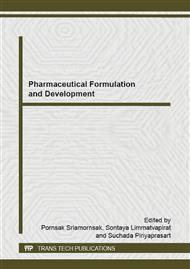[1]
A.K. Schwach, C.N. Vivien and R. Gurny: Eur. J. Pharm. Biopharm Vol. 50 (2000), pp.83-99.
Google Scholar
[2]
H.M. Kelly, P.B. Deasy, E. Ziaka and N. Claffey: Int. J. Pharm Vol. 274 (2004), pp.167-183.
Google Scholar
[3]
A.K. Schwach, C.N. Vivien and R. Gurny: Eur. J. Pharm. Biopharm Vol. 50 (2000), pp.83-99.
Google Scholar
[4]
H.A. Gad, M.A. El-Nabarawi and S.S. El-Hady: AAPS PharmSciTech Vol. 9 (2008), pp.878-884.
Google Scholar
[5]
H.K. No and S.P. Meyers: In: Muzzarelli RAA, edited by M.G. Peter, Chitin Handbook, pp.475-489, European Chitin Society (1997).
Google Scholar
[6]
E.I. Rabea, M.E.I. Badawy, W. Steurbaut and C.V. Stevens: European Polym Vol. 45 (2009), p.237–245.
Google Scholar
[7]
R. Sanghvi, R. Narazaki, S.G. Machatha and S.H. Yalkowsky: AAPS PharmSciTech Vol. 9 (2008), pp.366-376.
DOI: 10.1208/s12249-008-9050-z
Google Scholar
[8]
M. Lavertu, Z. Xia, A.N. Serreqi, M. Berrada, A. Rodrigues, D. Wang, M.D. Buschmann, and A.A. Gupta: J. Pharm. Biomed. Anal Vol. 32 (2003), pp.1149-1158.
DOI: 10.1016/s0731-7085(03)00155-9
Google Scholar
[9]
W. Sajomsang, S. Tantayanon, V. Tangpasuthadol and W.H. Daly: Carbohydr. polym Vol. 72 (2008), pp.740-750.
Google Scholar
[10]
H.M. Kelly, P.B. Deasy, E. Ziaka, and N. Claffey: Int. J. Pharm Vol. 274 (2004), pp.167-183.
Google Scholar
[11]
E. Esposito, V. Carotta, A. Scabbia, L. Trombelli and P.D. Antona: Int J Pharm Vol. 142 (1996), pp.9-23.
Google Scholar
[12]
E.I. Rabea, M.E.I. Badawy, T.M. Rogge, C.V. Stevens, M. Hofte, W. Steurbaut and G. Smagghe: Pest. Manag. Sci Vol. 61 (2005), pp.951-960.
DOI: 10.1002/ps.1085
Google Scholar
[13]
G. Crini, G. Torri, M. Guerrini, M. Morcellet, M. Weltrowski and B. Martel: Carbohydr. Polym Vol. 33 (1997), pp.145-151.
DOI: 10.1016/s0144-8617(96)00174-9
Google Scholar
[14]
J.Y. Chang, Y.K. Oh, H.S. Kong, E.J. Kim and D.D. Jang: J. Control. Release Vol. 82 (2002), pp.39-50.
Google Scholar
[15]
W. Sajomsang, S. Tantayanon, V. Tangpasuthadol and W.H. Daly: Carbohydr. polym Vol. 344 (2009), pp.2502-2511.
DOI: 10.1016/j.carres.2009.09.004
Google Scholar
[16]
J. Siepmann and N.A. Peppas: Adv. Drug Deliver. Rev Vol. 48 (2001), pp.139-157.
Google Scholar


